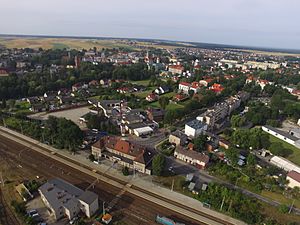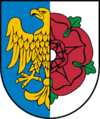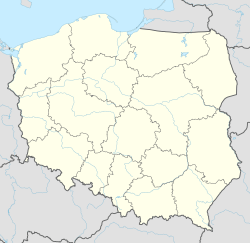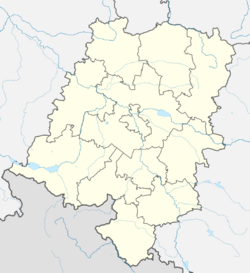Olesno facts for kids
Quick facts for kids
Olesno
|
|||
|---|---|---|---|

Aerial view of Olesno
|
|||
|
|||
| Country | |||
| Voivodeship | |||
| County | Olesno | ||
| Gmina | Olesno | ||
| First mentioned | 1226 | ||
| Town rights | 1275 | ||
| Area | |||
| • Total | 15.1 km2 (5.8 sq mi) | ||
| Elevation | 240 m (790 ft) | ||
| Population
(2019-06-30)
|
|||
| • Total | 9,374 | ||
| • Density | 620.8/km2 (1,608/sq mi) | ||
| Time zone | UTC+1 (CET) | ||
| • Summer (DST) | UTC+2 (CEST) | ||
| Postal code |
46-300
|
||
| Car plates | OOL | ||
| Website | http://www.olesno.pl/ | ||
Olesno is a charming town in Poland, located in the Opole Voivodeship. It's about 42 kilometers (26 miles) northeast of the city of Opole. Olesno is an important place because it's the capital of Olesno County and the main town of the Gmina Olesno area. It has a long and interesting history, with its roots going back many centuries.
Contents
A Glimpse into Olesno's Past
Olesno has been a home for people for a very long time. Even in the Neolithic era, which was thousands of years ago, people lived near the ancient Amber Road that passed through this area. This road was important for trading valuable amber.
Early Beginnings and Town Rights
The first time Olesno was mentioned in official papers was in 1226. A bishop named Wawrzyniec from Wrocław wrote about it. It might have been about a nearby village called Stare Olesno (Old Olesno) at first.
Olesno was part of different Polish duchies, like Opole and Silesia, which were smaller regions ruled by dukes from the Piast dynasty. In 1229, Duke Henry I the Bearded took control of the area. Olesno became an important center with a special official called a castellan.
The town officially received its "town rights" in 1275 from Duke Władysław Opolski. This meant it could grow, have markets, and govern itself more. There was even a mint in town, where coins were made!
Changing Rulers and Challenges
For a long time, Olesno was part of the Duchy of Opole. In 1327, this duchy became connected to the Kingdom of Bohemia. Later, in 1355, it became part of the Holy Roman Empire. However, local Polish dukes still ruled Olesno within the Duchy of Opole until 1532.
The town faced tough times, especially during the Thirty Years' War in the 1600s. In 1645, it returned to Polish rule under the House of Vasa, but then fell back to Bohemia in 1666. In 1708, a serious plague epidemic hit the town.
Under Prussian Rule and Polish Spirit
After the Silesian Wars in 1742, Olesno became part of the Kingdom of Prussia. In 1815, it joined the larger Province of Silesia. Even though the Prussian rulers tried to make people speak German, Olesno remained a strong Polish center in the 1800s. The first local Polish newspaper, Telegraf Górnośląski, started here in 1848.
Fighting for Independence
After World War I, Poland became an independent country again in 1918. Many people in Olesno wanted to rejoin Poland. This led to the Silesian Uprisings in 1919 and 1921. However, in a special vote in 1921, most people in Olesno voted to stay with Germany. So, Olesno remained part of Germany until after World War II.
During World War II, German authorities arrested Polish activists in Olesno. On January 21, 1945, Soviet troops took control of the town. After the war, Olesno finally became part of Poland again.
Modern Olesno
Today, Olesno continues to be a vibrant town. The Olesno Regional Museum, which tells the story of the area, was founded in 1960. It helps people learn about the town's rich past.
Images for kids
-
Wooden Saint Anne church, built in 1518, expanded in 1668-1670
-
Gothic Church of Saint Michael Archangel









